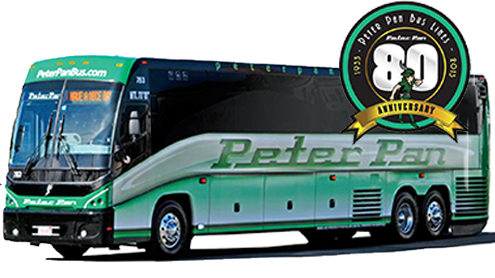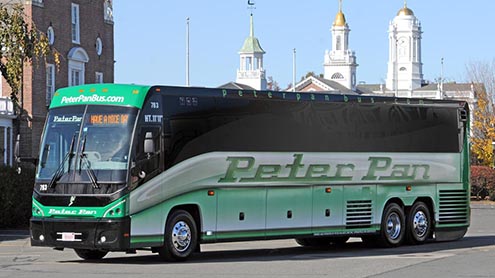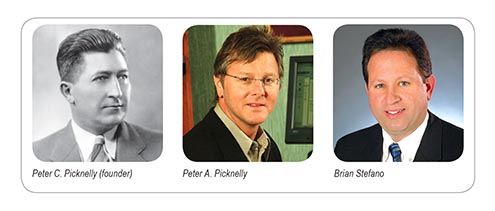
 What Peter Pan Bus Lines is doing to stay ahead of the curve
What Peter Pan Bus Lines is doing to stay ahead of the curve
By David Hubbard
Peter Carmine Picknelly started with a small transit operation in East Orange, NJ in 1920 and eventually founded Peter Pan Bus Lines in 1933. No guessing about the name, Peter Pan by J.M. Barrie was the favorite bedtime story of the Picknelly children, who grew — and are growing — to keep the dream and the family business growing successfully through four generations for 80 years.
Upon his death in 1964, he left the company to his son Peter L. Picknelly. He opened the Springfield Bus Terminal, current headquarters of Peter Pan Bus Lines, and his son Peter A. Picknelly serves as chairman and CEO.
President and CFO Brian Stefano began his career with Peter Pan Bus Lines as a controller 23 years ago and served as chief financial officer. Last year the company promoted him to president and CEO, the first time in the 80-year history that someone from outside the Picknelly family has served as president.
BUSRide spoke with the principals, who also include Joe Picknally, director, inventory control and fleet maintenance, and Christopher Crean, vice president, safety and security, on the state-of-the-company and how Peter Pan remains a vibrant industry leader.
Fleet operations and services
Peter Pan Bus Lines runs an all-MCI fleet of 200 modern motorcoaches. The relationship between Peter Pan and Motor Coach Industries (MCI), Schaumburg, IL, an 80-year old company as well, dates back to the 1970s.
As a partner with Greyhound since 1998, the two companies launched BoltBus in 2007 with 85 Prevost X3-45s. Northeast Express came four years later, a first class bus service with guaranteed seating, custom coaches with specially designed interiors and special guest services in private waiting areas in the terminals.
This past December, Peter Pan and Greyhound took a lesson from the street corner operators to introduce YO!, a Chinatown-to-Chinatown service operating out of New York City.
“These operators showed us a niche that needed to be filled, but they went about it so poorly, with no regard for safety,” says Peter Picknelly. “YO! applies the model correctly. We offer modern coaches and remove the chaos from the curbside experience. Customers can buy a ticket online and board in groups of 10 in an orderly manner.”
Brian Stefano says obtaining a permit for curbside service has become more stringent.
“We worked over a year to secure our curbside location for YO!,” he says. “That is probably not bad in the long run. It was getting out of hand with so many shadowy carriers not properly permitted.”
Peter Pan is using web-based technology to analyze customer demands and equipment needs in real time and implementing dynamic pricing.
“For instance, a few years ago we left ourselves open to provide unlimited seating at one price,” says Picknelly. “We have since moved from one regulated price into internet-based yield management.”
Stefano adds that Peter Pan is operating much more like an airline, where the price of a seat can fluctuate with every trip by the day by the hour. He attributes the success to smart shoppers who purchase tickets well in advance.
“But not every area is the same,” he says. “While the Boston internet market is strong, Philadelphia still caters primarily to walk-up customers who pay at the counter. Our policy is to let the customer tell us how they want to buy, and we accommodate their preferences.”
Safety and security
Christopher Crean attests to the power of the internet in the search for the most qualified individuals to hire as Peter Pan coach drivers, saying the new system actually delivers higher quality candidates.
The process begins with an online-only employee character analysis and initial testing.
“We make our selections and invite them in for a face-to-face interview,” says Crean. “Those who score high and make it through the interview enter our training program.”
He says the initial screening eliminates those with only the mechanical skills and who are unfamiliar with the technology required in modern bus operations.
The interview is more personal. The conversation assesses the candidate’s comfort level and preferences such as availability for work weekend work and holidays, and typical reactions in stressful situations — traffic congestion, schedule delays and irritable and irate passengers.
 “Our HR professionals have been conducting these interviews for a long time,” says Crean. “Anyone can put on a good show, but my team knows what questions to ask a candidate to draw out the true response and present the most accurate profile.”
“Our HR professionals have been conducting these interviews for a long time,” says Crean. “Anyone can put on a good show, but my team knows what questions to ask a candidate to draw out the true response and present the most accurate profile.”
Crean says Peter Pan drivers come from all walks of life. Some have years of driving experience, some have none.
“We can teach the requisite driving skills, but we are looking for the individual with the potential to become a professional Peter Pan motorcoach operator,” he says. “That person is a quality individual who is not only the safest driver possible, but also an affable tour host, parent and psychologist who can do it all with a smile.”
Training for Peter Pan
The six to eight-week Peter Pan performance-based driver training program prepares drivers to for all conditions and circumstances, and thoroughly verses them on the rules and regulations for passenger carriers and public roadways.
“We operate in a generation that relies heavily on technology such as GPS,” says Crean. “We train our drivers not to become too dependent and to do their own homework on the routes they travel. We want Peter Pan drivers to know all the landmarks and to be especially aware of all clearance restrictions such as bridges and tunnels. The old fashioned way will always work.”
“Problems arise when they fall into bad habits or the habits of others,” he adds. “Then we have to work to correct them.”
Crean says the FMCSA’s Compliance, Safety and Accountability (CSA) system has changed everything.
“What was acceptable five years ago is no longer,” he says. “No variance, no tolerance. Every aspect of an operation is now coming under greater scrutiny”
He says the company is updating its onboard surveillance with the installation of six-camera systems on each of the 200 Peter Pan coaches by the end of this year.
MCI maintenance training
“As everyone knows, motorcoaches has evolved into more of a process of electronic diagnosis as opposed to mechanical,” says Joe Picknally. “Our mechanics and technicians must show their commitment learning and relearning new technologies through continuous training and education.”
Peter Pan will be sending five of its top mechanics to the MCI Technical Training Institute in Louisville, KY.
“MCI is able to teach and train in areas our mechanics can’t get anywhere else,” says Picknally. “They will come back as our ‘super trainers’ to share what they learned with the rest of the crew in the six Peter Pan maintenance locations.”
Social media in play
The power of social media is not lost on Peter Pan. Case in point: the drivers, who in Picknelly’s mind are the most important people in the company.
“The number one compliment we receive on Facebook, Twitter and our website concerns our drivers,” he says. “The number one complaint is for our drivers. It shows how important they are in the mind of the customer.”
Peter Pan marketing and HR monitor all social media sites daily and respond, taking action in real time when a situation needs immediate attention.
“Every senior manager receives a weekly social media report revealing the good, bad and ugly,” says Picknelly. “They use the comments to gauge trends positively or negatively and shore up customer relations. Social media is a powerful indicator if used properly. If a business is not on top of this phenomenon, it can sink the company.”
Future just ahead
Picknelly says the focus is just ahead at what Peter Pan is doing at this time.
“Our company is perfectly sized for our geographic location,” he says. “There is so much opportunity in our current footprint. We will simply continue to refine our efforts and see where they take us.” BR

Peter Pan Bus Lines has a striving achievement, however, I would love to see the company expand into other reaches within the country into a global entity. A way we go should not take it, let’s be very slow.
I had a successful round trip from Baltimore to NYC and return with the return leg being handled by a Peter Pan bus picking up Greyhound ticket holders in bay #70 of the Port Authority.
The driver appeared competent and got me home safely. However, there was a negative event in the last 40 minutes for which the driver is responsible. He had a “shotgun” passenger in the single seat opposite the driver seat and below the driver’s storage compartment. She boarded in a special manner in New York, being seated first. She may have been a trainee, a deadhead driver, the wife or sister of a driver or a girlfriend. It matters not to me.
Shortly before we left, an employee wearing a read uniform boarded as the last passenger. We dropped him at the first rest stop out of the Port Authority towards Baltimore. He was familiar with the female passenger and the driver and they may have discussed the payment or non-payment of a fare as $40 dollars was mentioned by this man on exiting at the rest stop.
All was well until 40 minutes out of Baltimore when the special female passenger and the driver apparently known to each other became more familiar in their conversation and discussed mutual acquaintances and the female’s daughter. The conversation got louder and more animated and I put in my earplugs. As we got closer and closer there were at least 2 instances when the driver took his hand off the wheel to excitedly make a point in the conversation.
Finally, we arrived in Baltimore. We were approaching on 95 from the north and approached the South Baltimore exits with which I am familiar. We actually went through a tunnel which surprised me. The driver made an amazing series of switchbacks to eventually approach Haines street from the soutwest approach and turn right behind the Holiday Inn into the Greyhound yard at Haines. I am not saying this is incorrect and perhaps this is the way that it must be done for a large bus. It had me inspecting Google Maps to figure out the sequence of this approach, Maybe he was avoiding an Oriole’s game leaving out and avoiding traffic. At one point during what I would characterize as this switchback maneuver, he honked the horn at a car not going fast enough for him as if he was impatient with himself really. This was out of character from the rest of the trip and made me think that he missed the exit by being distracted by the special passenger rather.
In any case, the special passenger was a distraction to this driver and did not make him look good in the eyes of at least one passenger. I would like to let him know this so that he improves what is obviously a good career choice for him. He was a good driver generally.
This bus was labeled 2453 PPP out of Port Authority on June 1st @ 5:00P and was on time. Thanks for reading.